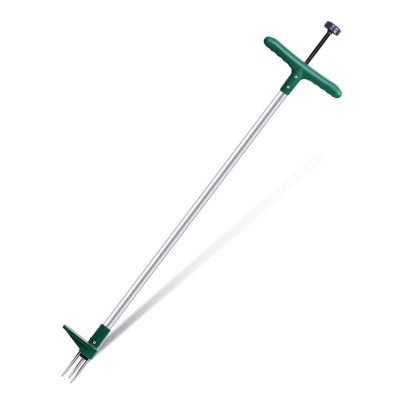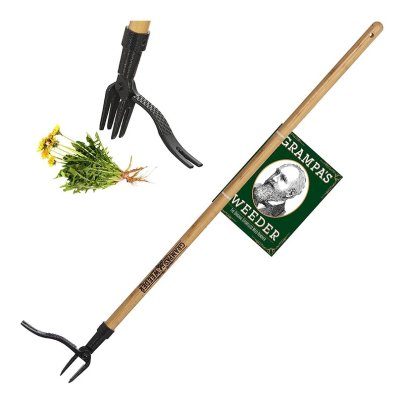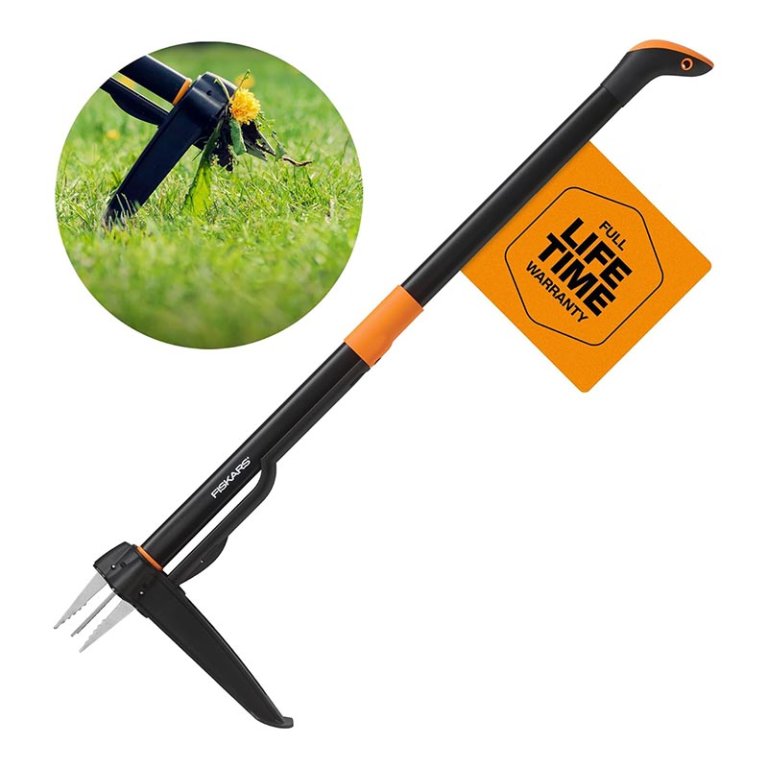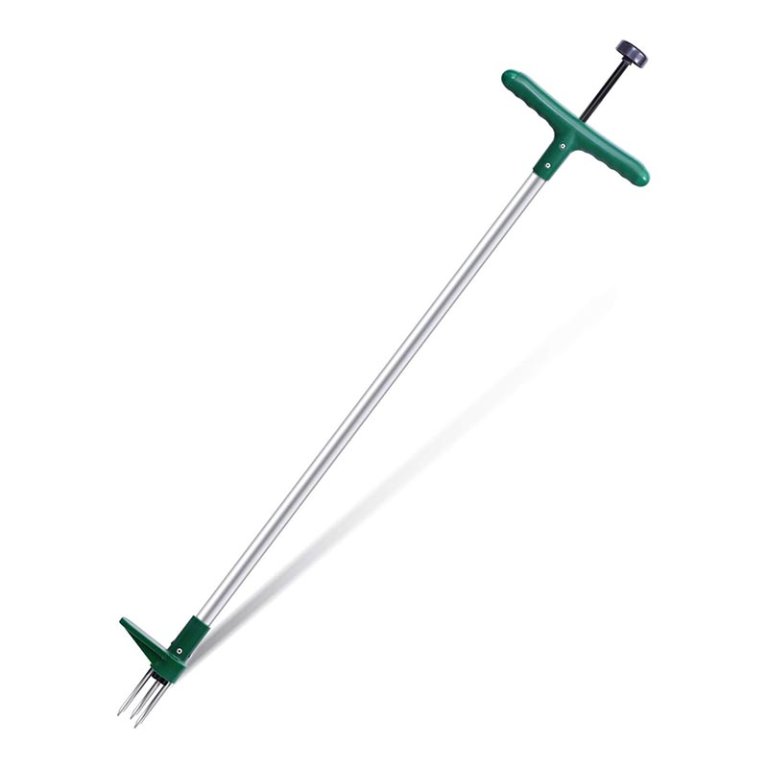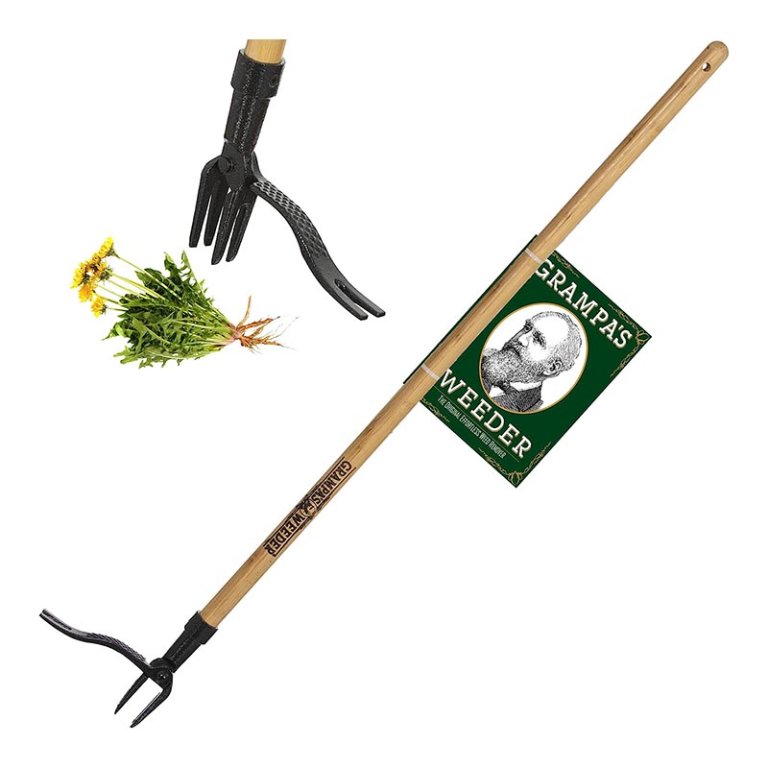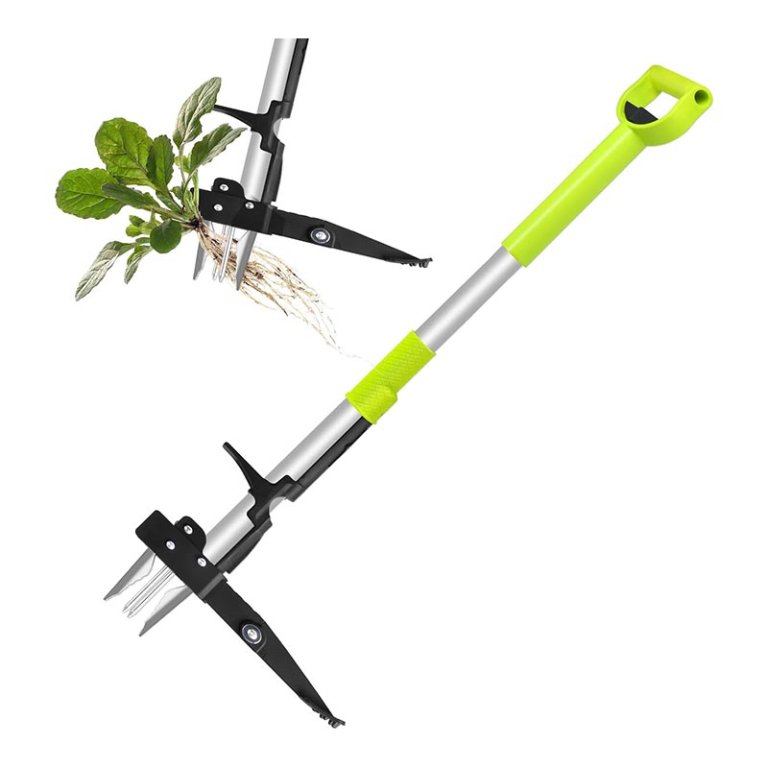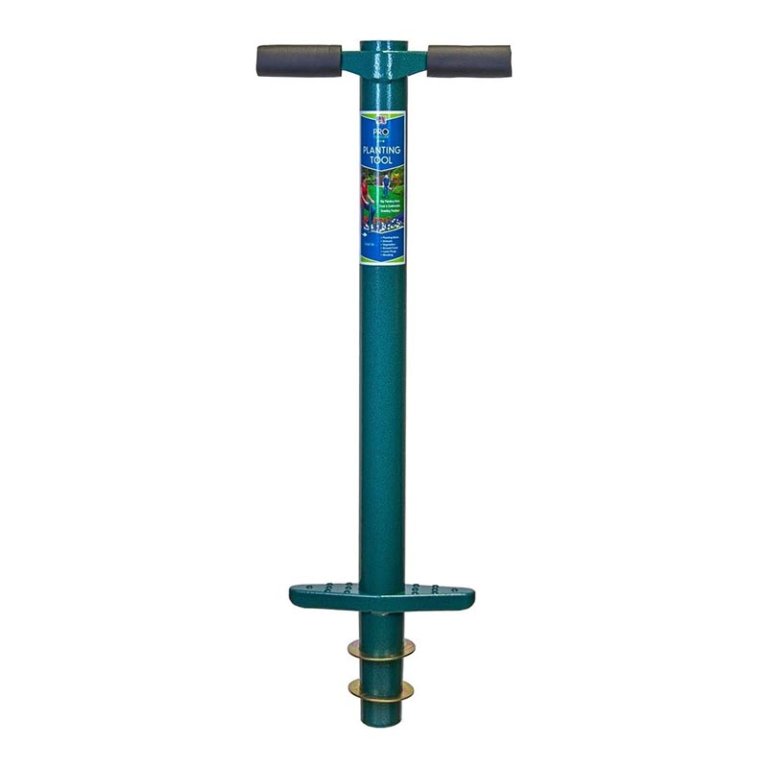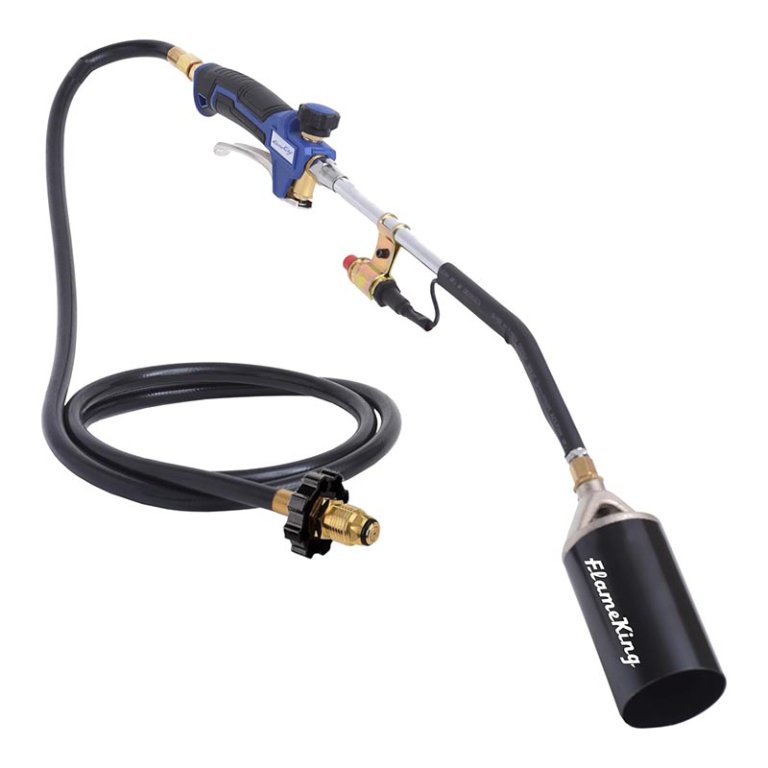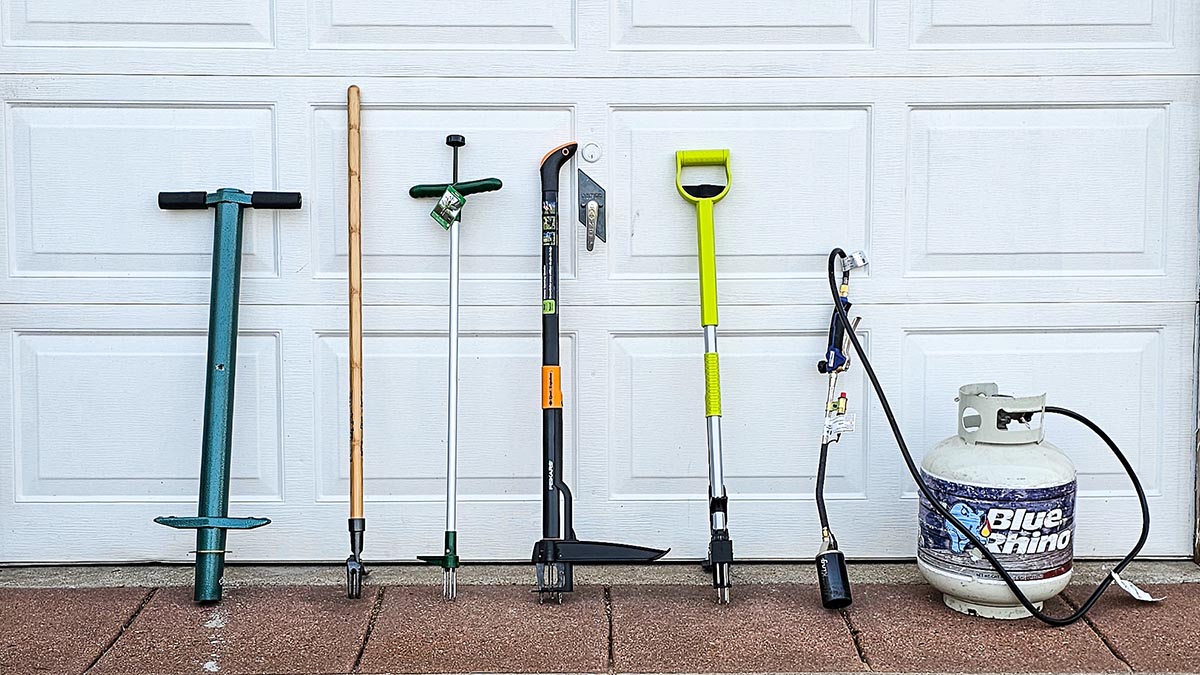
We may earn revenue from the products available on this page and participate in affiliate programs. Learn More ›
Stand-up weeders are an excellent investment for anyone who finds that bending and kneeling to pull weeds strains their back. Weeding by hand can be physically exhausting, especially for seniors or those with mobility issues. We researched more than 20 stand-up weeding tools and then tested six top-rated models to determine which ones lived up to their promise of making weed removal easier.
We used these weed-pulling tools to root out troublesome weeds in our lawns and gardens while noting which ones worked best for various types of weeds and soils. Our favorite was the Stand-Up puller from Fiskars thanks to its durable construction and ergonomic handle for long hours of gardening. Keep reading to learn more about these labor- and back-saving tools, and find out how the following models earned a spot in this guide of the best stand-up weeders on the market today.
- BEST OVERALL: Fiskars 4-Claw Stand-Up Weed Puller
- BEST BANG FOR THE BUCK: Ohuhu Stand-Up Weeder and Root Removal Tool
- BEST CLASSIC STYLE: Grampa’s Weeder The Original Stand-Up Weed Puller
- BEST ERGONOMIC: Gardtech Original D-Shape Weeder Puller
- MOST VERSATILE: ProPlugger 5-in-1 Planting Tool
- ALSO CONSIDER: Flame King Auto-Ignition Propane Torch
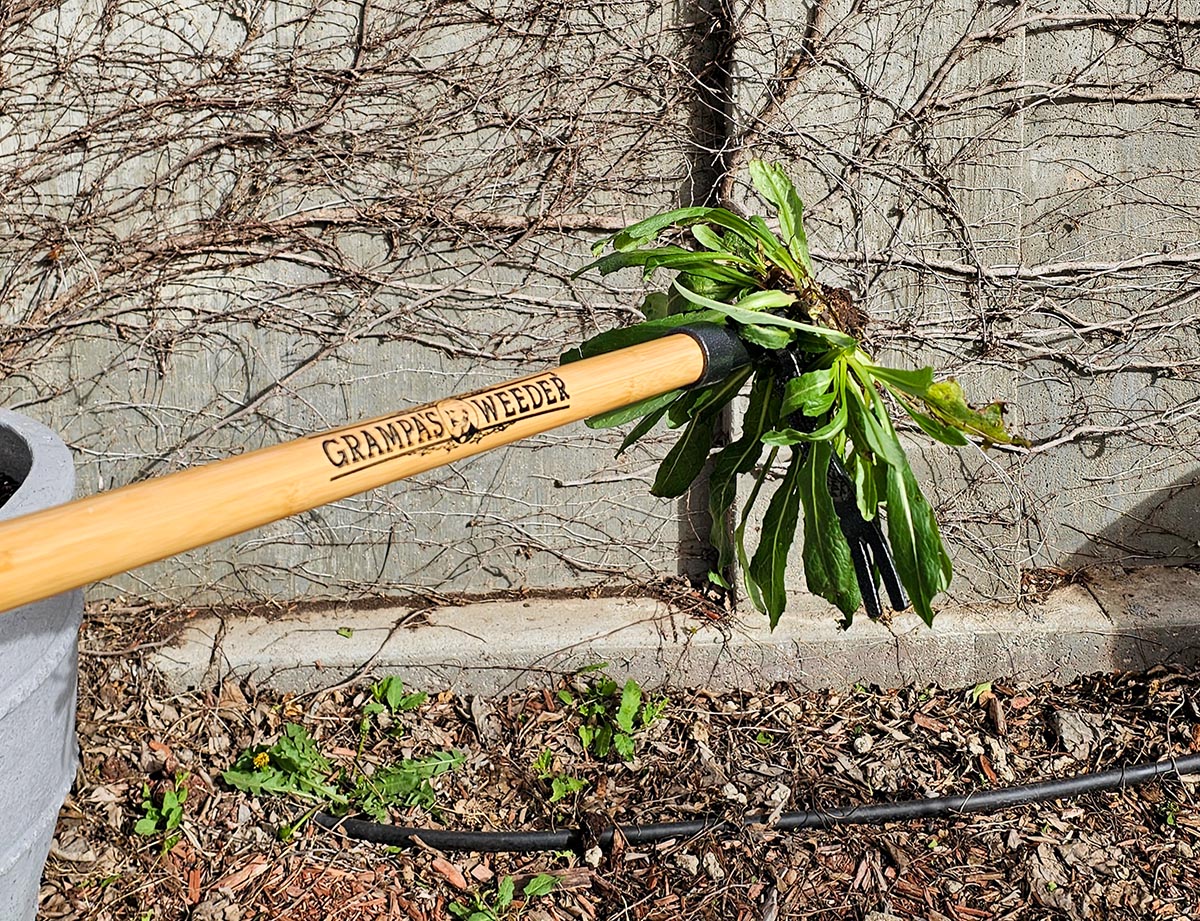
| Primary Materials | Length | Weight | |
| Fiskars 4-Claw Stand-Up Weed Puller | Aluminum and stainless steel | 39.25 inches | 2.3 pounds |
| Ohuhu Stand-Up Weeder and Root Removal Tool | Stainless steel and aluminum | 39 inches | 1 pound |
| Grampa’s Weeder The Original Stand-Up Weed Puller | Steel and bamboo | 44 inches | 3 pounds |
| Gardtech Original D-Shape Weeder Puller | Aluminum, steel, and plastic | 40 to 47 inches | 4 pounds |
| ProPlugger 5-in-1 Planting Tool | Powder-coated carbon steel | 35 inches | 6 pounds |
| Flame King Auto-Ignition Propane Torch | Steel, metal, and rubber | 108 inches (includes hose) | 3.49 pounds |
Our Top Picks
The garden weeder tools on our list of top picks excelled in our hands-on tests, allowing us to stand up while successfully pulling weeds. Each weed-pulling tool is best suited for certain types of weeds and soils—and each has its pros and cons. If you’re looking for a standing weed puller, one of these models will likely fit your needs. Read on to discover some of the best stand-up weeders available today.
Best Overall
Fiskars 4-Claw Stand-Up Weed Puller
What We Like
- A popular weed extractor tool
- Made from rust-resistant stainless steel and aluminum
- Combines ergonomic offset handle
- Reinforced foot platform
- Easy-eject mechanism
What We Don’t Like
- Not well suited to pulling weeds in heavy or dry soils
Product Specs
- Primary materials: Aluminum and stainless steel
- Length: 39.25 inches
- Weight: 2.3 pounds
This Bob Vila Approved product carries our brand’s highest level of recommendation.

Bob Vila Approved recognizes the household and DIY products that impressed us most in our real-world testing and that exemplify core values of the Bob Vila brand, including craftsmanship, innovation, and value for the dollar. Winners of this designation come recommended by our professional review team and are personally approved by Bob Vila.
Our Ratings: Ease of Use 4.5/5; Ergonomics 4/5; Effectiveness 4.3/5; Durability 4/5; Value 4.75/5
The Fiskars 4-claw weed removal tool features four serrated stainless steel claws that firmly grasp and remove dandelions, thistles, and other invasive weeds. However, when we first tried it out, we had no luck—we stepped on the foot pedal to drive the stakes into the base of a weed, but when we pulled the weeder out of the ground, the weed remained in the ground.
Then, we referred to the instructions printed on the side of the tool’s shaft. Rather than pulling the weeder straight out of the ground, we had to tip it to the side, which allowed the serrated blades to pull the weed out, roots and all. After removing the weed, we used the easy-eject mechanism to drop it into a bucket before moving on to the next weed.
The weeder’s aluminum shaft is just over 39 inches long and weighs only 2.3 pounds, limiting muscle fatigue. We tried the Fiskars stand-up weeder on dry, compacted, clay-based soil and looser, aerated soil. We also ran tests before and after it rained and found the tool performed best on the looser soil the day after a light rain. It was partially successful on clay soil but only for weeds with small root systems.
This Fiskars model is a highly effective standing weed puller. Just remember to follow the instructions and use the tool when the ground is slightly moist for best results.
Read our full review: Fiskars 4-Claw Stand-Up Weed Puller
Get the Fiskars stand-up weeder at Amazon, The Home Depot, or Walmart.
Best Bang for the Buck
Ohuhu Stand-Up Weeder and Root Removal Tool
What We Like
- Durable, rust-resistant, and lightweight
- Simple push-and-twist operation
- Push-button release slides the weed out
What We Don’t Like
- While normally durable, some customers report broken handles
Product Specs
- Primary materials: Stainless steel and aluminum
- Length: 39 inches
- Weight: 1 pound
Our Ratings: Ease of Use 4/5; Ergonomics 5/5; Effectiveness 4/5; Durability 4/5; Value 4.5/5
You don’t have to spend a lot to get the benefit of a stand-up weed puller. The Ohuhu weeder uses a twist-and-pull technique, and despite the affordable price point, it scored very well in our tests.
The tool’s three claws are made from stainless steel, and its 39-inch shaft is aluminum. While the claws are not serrated—a common feature on most tools for weed removal—the weeder still successfully removes weeds. We positioned the claws over the center of a weed, stepped on the foot pedal to drive the claws into the soil, and then used the tool’s T-handle to twist it a full rotation before pulling it out of the ground. The weed came out with the tool, roots intact.
This weeder has a release lever that ejects the weed, but we found it just as simple to push the weed off the tool with our foot. That way, we could continue holding the tool with both hands and quickly move on to another weed. The combination of performance, materials, and price makes this one of the best stand-up weeders we tested for shoppers on a limited budget. However, the Ohuhu weeder is best suited for small weeds and moist soils; we removed dandelions with relative ease but weren’t able to eliminate large thistles. Use it the day after rain or after watering for best results.
Get the Ohuhu stand-up weeder at Amazon.
Best Classic Style
Grampa’s Weeder The Original Stand-Up Weed Puller
What We Like
- Traditional tool with heavy-duty steel head
- Designed to last a lifetime
- Excellent leverage and is particularly suited to tall gardeners
What We Don’t Like
- Teeth are relatively close together
Product Specs
- Primary materials: Steel and bamboo
- Length: 44 inches
- Weight: 3 pounds
Our Ratings: Ease of Use 4/5; Ergonomics 4/5; Effectiveness 4.5/5; Durability 5/5; Value 4.2/5
According to the card that came with this long-handle weed tool, the Grampa’s weed puller has been around for over a century. It’s a simple weeder with the same classic design as several models we tested. It works by pushing the steel blades via a foot pedal into the center of the weed and then tipping the tool to the side to pull the weed out by its roots.
Like similar stand-up weeders we tested, Grampa’s stand-up weeder works best on slightly moist soil. However, that’s not the fault of the weeder: The root system of weeds in dry, compact soil tends to break off rather than pull out, which may allow them to regrow.
At 44 inches long, this model is a good choice for taller users. It features a smooth bamboo shaft, and the head is made from sturdy powder-coated steel. We liked the vintage-style aesthetic, and it’s built to last—no plastic components on this weeder.
Get the Grampa’s stand-up weeder at Amazon or Ace Hardware.
Best Ergonomic
Gardtech Original D-Shape Weeder Puller
What We Like
- D-handle, large foot pedal, and adjustable shaft
- 2 options: a sliding hand release and a foot pedal
- Shaft adjusts from 39 to 47 inches to suit users of any height
What We Don’t Like
- Limited effectiveness on large weeds with deep root systems
Product Specs
- Primary materials: Aluminum, steel, and plastic
- Length: 40 to 47 inches
- Weight: 4 pounds
Our Ratings: Ease of Use 4/5; Ergonomics 5/5; Effectiveness 4.3/5; Durability 4/5; Value 4/5
A nonslip D-handle combined with a large foot pedal and an adjustable shaft height makes the Gardtech stand-up weed puller user-friendly and comfort oriented. While this weeder works like other step-and-tilt weeders we tested, the larger handle provided a more solid grip and offered increased stability when we inserted the blades into a weed’s roots. Plus, the shaft is adjustable from 39 to 47 inches, so it accommodates users of any height.
Weed removal was simple via a sliding hand release or a foot pedal release. The hand release made it easy to deposit the pulled weeds into a pile or bucket, while the foot release worked better for dropping the weeds on the ground and raking them up later.
Like other stand-up weeders we tested, the Gardtech weeder worked best in slightly damp soil. In addition to easily pulling small weeds, this weeder was relatively effective at pulling medium-size weeds. However, it had some difficulty with large thistles, but that’s to be expected as their roots can extend several feet. The trick to using this or any other stand-up weeder is to remove the weeds before their roots become too large.
Get the Gardtech stand-up weeder at Amazon.
Most Versatile
ProPlugger 5-in-1 Planting Tool
What We Like
- 5 useful garden functions from a single tool
- Made from strong and durable carbon steel
- Soil and weeds are held within the tool
What We Don’t Like
- Heavier than other similar models
- Leaves a larger hole that may require refilling after weeding
Product Specs
- Primary materials: Powder-coated carbon steel
- Length: 35 inches
- Weight: 6 pounds
Our Ratings: Ease of Use 4/5; Ergonomics 4/5; Effectiveness 4.3/5; Durability 5/5; Value 4/5
This versatile gardening tool from ProPlugger features five unique functions. It is a lawn and sod plugger, a stand-up weeder, a fertilizing tool, a soil sampler, and a tool for planting flowers. In our tests, this model efficiently removed weeds using a different method than other weed pullers.
The ProPlugger is a hollow steel pipe with a welded T-handle at one end and steel foot pedals at the other end. You sever the weed’s roots by positioning the end of the pipe over a weed and then stepping on the foot pedal to force the pipe into the ground. The weed remains in the hollow pipe after you pull the pipe back out of the soil. We found the best way to release the soil plug was to turn the tool upside down and shake it out. We also discovered we could remove several weeds before turning the tool over and shaking them out.
One of the biggest benefits of the ProPlugger is that it has no breakable parts. The downside is that it leaves a hole about 2 inches in diameter that we had to fill with dirt. This weeder works well in slightly moist soil, but it also works in dry soil because you can put both feet on the steel foot pedals to drive the pipe into the ground.
At 6 pounds, the ProPlugger is heavier than most weeders, but it can replace several lawn and garden tools, making it the most versatile of the weeders we tested.
Get the ProPlugger stand-up weeder at Amazon, The Home Depot, or Walmart.
Also Consider
Flame King Auto-Ignition Propane Torch
What We Like
- Auto-ignition, flame control knob, and boost lever
- Highly efficient for burning weeds
- Good for use in areas where weed pullers won’t work
What We Don’t Like
- Potential fire risk
Product Specs
- Primary materials: Steel, metal, and rubber
- Length: 108 inches (includes hose)
- Weight: 3.49 pounds
Our Ratings: Ease of Use 5/5; Ergonomics 4.5/5; Effectiveness 4.8/5; Durability 5/5; Value 5/5
Weed pullers are great for removing weeds from lawns and garden soil, but they don’t work well in rock gardens, gravel driveways, or cracks in concrete sidewalks. No worries—we found a solution. The Flame King propane torch made it quick and easy to kill the invasive weeds growing in our rose bed, which is filled with river rocks.
The Flame King features an auto-ignition system, a flame control knob, and a boost lever that turns up the flame power. It has a long hose and a safety connector valve attached to a standard propane tank. When we were ready to test, we opened the valve on the propane tank and pressed the push-button igniter, creating a soft flame at the end of the torch. By pulling the control lever, we could boost the rate of the flame until it was similar to a blow torch.
To use this type of stand-up weeder, simply point the flame at the offending weeds and burn them, or if the weeds are green, damage them to the point that they wilt and die. Not all of the weeds burned immediately in our tests, but virtually all of them shriveled and died by the third day.
Using a weed burner comes with some obvious caveats: Make sure you don’t accidentally burn any desirable plants, and check that your community allows weed burners. And use good sense—even if you are free to use a weed burner, burning weeds may pose an unacceptable fire risk if the surrounding foliage is dry.
Get the Flame King propane torch weeder at Amazon or The Home Depot.
Jump to Our Top Picks
How We Tested the Best Stand-Up Weeders
Testing Stats
- Products tested: 6
- Hours spent testing: 9 hours
- Tests performed: 3
- Price range: $35 to $55
We found dozens of styles of stand-up weeders when we began searching for models to put through our hands-on tests. We carefully researched each stand-up weeder, looking for the durability and features of an overall high-quality ergonomic garden tool. We paid some attention to the brand—after all, Fiskars manufactures some of the best lawn and garden tools, so we wanted to include them. Still, we didn’t automatically eliminate a weed-puller tool from a lesser-known company if it was made of quality materials and had high customer satisfaction.
In our hands-on tests, we first reviewed each weeder tool for durability and quality: checking welds, inspecting connection links, and noting if the weeder could withstand moisture without rusting or corroding. Then, we tested each stand-up weeder to see if it lived up to the manufacturer’s basic claim of effectively pulling weeds—both large and small. We also tested each weeder on hard and soft soil. Finally, we tested each weeder before and after watering the lawn to see whether it worked better on dry or moist soil.
During our testing, we awarded points to each stand-up weeder based on a rubric. The better the weeder performed on a test, the more points we gave it. After testing, we averaged the scores for each weed-pulling tool to find the best overall performer and determine the most appropriate category for each of the other models.
| Ease of Use | Ergonomics | Effectiveness | Durability | Value | |
| Fiskars 4-Claw Stand-Up Weed Puller | 4.5 | 4 | 4.3 | 4 | 4.75 |
| Ohuhu Stand-Up Weeder and Root Removal Tool | 4 | 5 | 4 | 4 | 4.5 |
| Grampa’s Weeder The Original Stand-Up Weed Puller | 4 | 4 | 4.5 | 5 | 4.2 |
| Gardtech Original D-Shape Weeder Puller | 4 | 5 | 4.3 | 4 | 4 |
| ProPlugger 5-in-1 Planting Tool | 4 | 4 | 4.3 | 5 | 4 |
| Flame King Auto-Ignition Propane Torch | 5 | 4.5 | 4.8 | 5 | 5 |
What to Consider When Choosing a Stand-Up Weeder
No one wants an ugly lawn strewn with unwieldy weeds. Several factors affect the functionality of stand-up weeders, including the blade type, material, handle length, and overall ease of use. Keep reading to learn about the most important features to consider when choosing the best stand-up weeder.
Type
While all stand-up weeders serve the same purpose, they differ in the methods they use to extract weeds.
- Multiclaw weeders have a four-claw power head that pulls weeds out at the root. Some models include a foot pedal to close the claws.
- Twist-and-pull weeders operate by pushing the blades or tines into the soil and twisting the handles to remove the weed and root system.
- Single-blade weeders have one long blade to either remove weeds or create holes for planting flowers, bulbs, or other plants.
- Plug-style weeders have a cylindrical base rather than blades to remove plugs of earth for weeding, planting bulbs, or testing soil.
- Weed-burning weeders connect to portable propane tanks and burn the offending weeds so the plant dies.
Material
Consider the construction of a stand-up weeder before making a purchase, particularly the shaft, claws, and handles.
- Steel weeders are durable but often costly. Stainless steel and carbon steel won’t rust or corrode when exposed to moisture.
- Aluminum is lightweight yet sturdy.
- Plastic is used to create the shafts and handles of some models of stand-up weeders.
- Bamboo, an eco-friendly material, makes a lightweight shaft for a stand-up weeder.
Yard Conditions
Stand-up weeders aren’t for every weed woe. Although they work quite well on both surface and deep-rooted weeds, including dandelions, thistles, and most other invasive species, they aren’t a good match for dense root mats, crabgrass, or Oxalis corniculata (creeping woodsorrel or sleeping beauty), which you must pull out by hand or treat with a herbicide. Stand-up weeders also don’t perform well on hard, dense soils.
Since most stand-up weeders remove relatively sizable chunks of earth, they’re not the ideal tool for flower beds or vegetable gardens because of the risk of damaging the surrounding more delicate plants. Garden tip: Weeding is easiest shortly after rainfall when the ground is slightly moist but not soggy.
Length and Weight
Since stand-up weeders reduce the need to kneel and bend, choosing the right height is important. Look for a shaft long enough to pull weeds without stooping, hunching, or bending. Stand-up weeders are typically between 35 inches and 45 inches in length, but some models feature an extendable telescopic handle.
They generally weigh between 1 and 5 pounds. If having a lightweight weeder is important, look for a plastic, aluminum, or bamboo shaft.
Handle
Some ergonomically designed handles feature a cushioned grip to avoid hand strain and discomfort. An O-shaped handle allows the versatility to grasp in a variety of positions.
The best stand-up weeders feature buttons or sliding mechanisms on the handle to release the weed after extraction, allowing you to dispose of it neatly without bending over.
Additional Features
Some stand-up weeders are equipped with a few extras to make banishing weeds faster and easier:
- Metal foot pedals make pushing the tines or claws into the soil easier.
- Weed-release systems simplify the process of removing the pulled weeds from the tines.
- Serrated claws firmly grasp onto weeds to extract them.
FAQs
A tool to pull weeds may seem like a simple product, but there are differences among models. For example, a weed puller differs from a weed eater in that a weed puller removes the entire plant, including its roots. Check out the answers to these frequently asked questions to learn more about stand-up weeders.
Stand-up weeders work in one of several ways. Most commonly, you will push the claws or tines into the ground around the weed and tilt or twist the handle to extract the weed. It is common for this type of weeder to have a release mechanism that allows you to dispose of the weed and root system in a disposal bin or trash bag.
Pulling weeds can cause more weeds to grow, especially if you inadvertently distribute the weeds you’ve pulled across the lawn. While using herbicides is the most effective way to prevent further weed growth, chemicals have disadvantages as they can be harmful to children, pets, and the planet.
It depends on the type of weed and its condition. After extraction, you can add weeds to a compost heap as long as they aren’t bearing seed heads that might contaminate it. It’s a good idea to let them wilt first so they won’t take root and regrow. Otherwise, you can put weeds in the trash or an organic waste-disposal bin during spring or fall lawn cleanup.
In most cases, it’s best to pull the weeds first rather than risk spreading seeds over the entire lawn during mowing.
If the soil is dry and hard, watering the soil will soften it and increase the likelihood that the weeder can successfully pull the weeds out by their roots.
Meet the Tester
Glenda Taylor is a product tester and writer specializing in the construction, remodeling, and real estate industries. She and her husband own a general contracting company, and Taylor is experienced in both residential and commercial building applications. She tests a wide range of power tools as well as other home improvement, household, and lawn-and-garden products.
Additional research provided by Savannah Sher.

